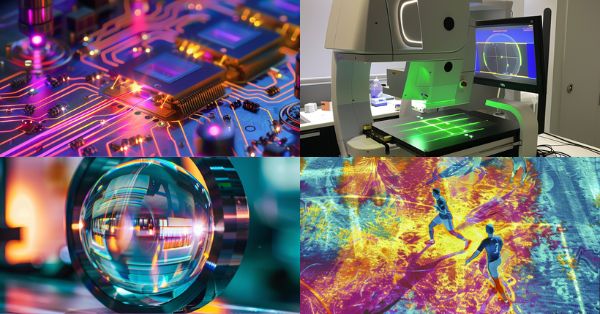Mar. 26, 2024

Visible Lasers
As the quest to integrate visible laser sources on-chip spreads through the integrated photonics sector, applications in numerous technology areas appear poised to benefit. One -- quantum, and especially quantum devices -- shows particular promise due to the range of related applications that visible sources already enable. From quantum computing to atomic clocking/precision timekeeping, to simulation, cryptography, and advanced sensing, this article focuses on present state of the link between a discernible trend in laser technology and applications in one highly coveted technology area. The article further aims to establish the nature of the relationship between integrated VIS sources and quantum applications, to determine how advances on one side of the equation are enabling -- or hindering -- growth to the other.
Key Technologies: Visible Lasers, Integrated Lasers, Integrated Photonics, PICs, Quantum Information Science, Precision Timekeeping, Visible Laser Diodes
Laser Scanners
Galvanometer-based optical scanners, or "Galvos," are used in a range of laser applications, including point-and-hold, vector scanning, and raster scanning. This article focuses on raster scanning – a technique in which the beam is deflected horizontally back and forth very quickly, and vertically up-and-down much more slowly, thus allowing the laser to cover a rectangular area. Raster scanning is used in applications such as 3D printing, and biomedical applications such as confocal microscopy and OCT. Though galvos have been used to produce raster images for nearly 50 years, simple motion profiles have been used in most instances. While these profiles/waveforms, such as triangle-wave and sawtooth-wave motions, are easy to understand, they are not optimal for galvo scanners, since the rate-of-change is too high at the turn-around point, and also because these simple waveforms may excite resonances in the rotor/mirror system, which may lead to image distortion. This article describes a set of superior motion profiles to be used as an alternative to triangle-wave and sawtooth waveforms, involving the use of so-called cycloid motions. With easy implementation, predictable results, and the ability to avoid exciting resonances of the galvo’s rotor/mirror system, cycloid motions offer numerous advantage to end users.
Key Technologies: Laser Scanners, Raster Scanning, Galvanometers, Galvo Motors
Reflective Optics
This article explores the role that reflective optics play in the function of optical systems, including those that appear in laboratory research optical bench setups, industrial applications, health and life science applications, and large-scale optical systems used for astronomy and high energy physics. With a focus on trends in assembly, fabrication, and system incorporation; coatings preferences; mainstay and emerging applications; substrates and geometries; and challenges to obtaining optimal performance, this report on mirror technology aims to inform best-practices for manufacturers, system integrators, and end-users.
Key Technologies: Reflective Optics, Mirrors, Metallic Coatings, Thin-Film Coatings, Optical Assembly, Diamond Turning, Freeform Mirrors, Liquid Mirror Optics
3D Imaging
This comprehensive look into the evolution of 3D Imaging in industrial applications spotlights sectors for which 3D imaging technologies are in demand, including aerospace, automotive, and more. As 3D imaging technology as a whole has evolved, changes at the components and software level in particular that are yielding improved image quality, resolution and precision, ease of use, and greatly expanded reliable and robust use cases. The article will specifically look at: The broad range of 3D imaging techniques (and recent advancements in the technologies); The shift toward application-specific solutions and the automation tasks that they enable;Key considerations that may impact component specification; and thoughts on best practices for 3D imaging application implementation.
Key Technologies: 3D Imaging, Machine Vision, 3D Stereo Imaging; ToF Imaging, Lidar, and Structured Light; Vision Software
Photonics in Sports
Contributing editor Michael Eisenstein dives into the role that optical and photonic systems play in athletics, where thermographic imaging systems for performance monitoring; AI-aided motion detection systems; and AR/VR, smart sensing, and positioning systems are deployed in numerous settings and environments to improve game-flow and optimize performance. Eisenstein explores the broad range of distinct use cases for photonic products and systems in this field, bridging light-based technology and individual and team sports.
Key Technologies: Thermal imaging, AR/VR, Lidar, High-Speed Imaging, Wearable Sensors
AKL 2024 -- International Laser Technology Congress Coverage
Contributing editor Andreas Thoss files his report from AKL '24 -- International Laser Technology Congress in Aachen, Germany. Mainstay technology areas including materials processing, laser-based additive manufacturing, and beam sources are joined by dedicated programs in digitalization and AI for production and quantum technology. Thoss covers key trends from the three day congress, speaking with industry leaders and industry leading companies at this Fraunhofer ILT-headed event.
Key Technologies: Lasers, Laser Materials Processing, Laser-based Additive Manufacturing, Beam Sources, Quantum (Laser Applications)
Download Media Planner